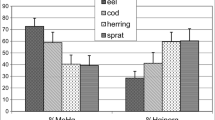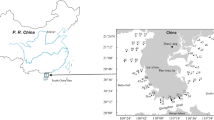Abstract
The present study is a survey on mercury and arsenic pollution in two sedentary fish species stationed in or close to the Glomma estuary in the Hvaler archipelago, Norway. Mercury and arsenic were determined individually in 80 flounder (Platichthys flesus L.) and 100 cod (Gadus morhua L.). The fish were caught at five different localities near or in the relatively polluted Glomma estuary. There were significantly higher mercury and arsenic concentrations in fillets of flounder than in fillets of cod (wet weight), 0.15 vs. 0.08 mg/kg and 5.2 vs. 4.1 mg/kg, respectively. Seasonal variation in mercury concentration was only found in flounder, with a significantly higher level in spring than in autumn. A significant increase in mercury content with increasing age was found for both species. For cod, a significantly higher arsenic level was found on the outer stations as compared to the inner stations, while arsenic levels in flounder was less dependent on sampling site.
Similar content being viewed by others
References
Bhattacharyya GK, Johnson R (1977) Statistical concepts and methods. John Wiley & Sons, NY, p 639
Bryan GW (1976) Heavy metal contamination in the sea. In: Johnston R (ed) Marine pollution. Academic Press, London, p 729
Christensen JM (1964) Burning of otoliths, a technique for age determinations of soles and other fish. J Cons Cons Int Explor Met 29(1):73–81
Clark RB (1986) Marine pollution. Clarendon Press, Oxford, p 215
Dannevig A (1954) The littoral cod of the Norwegian Skagerak coast. Rapp Proc 'v Reun Cons Int Explor Mer 136:7–14
Eisler R (1981) Trace metal concentration in marine organisms. Pergamon Press, New York, p 687
(1988) Arsenic hazard to fish, wildlife, and invertebrate: a synoptic review. U.S. Fish and Wildlife Service, Biological Report 85 (1.12)
Falconer CR, Shepherd RJ, Pirie JM, Topping G (1983) Arsenic levels in fish and shellfish from the North Sea. J Exp Mar Biol Ecol 71:193–203
Hansen ØK (1979) Skrubba,Platichthys flesus (L.), i Oslofjorden og dens forhold til forurensing. Biologien til skrubba i Oslofjorden, med vekt på vekst- og forplantningsforhold. Cand. real thesis, University of Oslo, Norway
Haugen A, Hoie R, Norheim G (1985) Automated hydride generator determination of selenium and mercury in biological material. Presented at 10th Nordic Atomic Spectroscopy and Trace Element Conference. Turku, Finland 6–9 August 1985
Julshamn K, Ringdal O, Slinning KE, Braekkan OR (1982) Optimization of the determination of selenium in marine samples by atomic absorption spectrometry: Comparison of a flameless graphite fur nace atomic absorbtion system with a hydride generation atomic absorbtion system. Spectrochim Acta 37B:473–482
Julshamn K, Slinning K-E, Haaland H, Bøe B, Føyn L (1985) Analyse av sporelementer og klorerte hydrokarboner i fisk og blåskjell fra Hardangerfjorden og tilstøtende fjordområder hasten 1983 og våren 1984. Norwegian Directorate of Fisheries, Rapporter og meldinger 16/85
Knutzen J (1984) Basisundersøkelser i Hvalerområdet og Singlefjorden. Miljogifter i organismer 1980–1981. Norwegian Institute of Waterresearch, Report 122/84
Larsen RJ, Marx ML (1986) An Introduction to mathematical statistics and its applications. Prentice-Hall International, Englewood Cliffs, NJ, p 625
Lindberg S, Stokes PM, Goldberg E, Wren C (1987) In: Hutchinson TC, Meema KM (eds) Lead, mercury, cadmium and arsenic in the environment. John Wiley & Sons, Chichester, p 360
Lunde G (1974) The analysis and characterization of trace elements, in particular bromine, selenium and arsenic in marine organisms. Ph.D. thesis, Central Institute for Industrial Research (CIIR), Oslo, Norway
Luoma SN (1983) Bioavailability of trace metals to aquatic organisms-a review. Sci Total Environ 28:1–22
Marthinsen I, Staveland G, Skaare JU, Ugland KI, Haugen A (1991) Levels of environmental pollutants in male and female flounder (Platichthys flesus L.) and cod (Gallus morhua L.) caught during the year 1988 near or in the waterway of Glomma, the largest river of Norway. I. Polychlorinated biphenyls. Arch Environ Contam Toxicol 20:353–360
Monfelt C, Lindeström L (1989) Undersokninger an skrubbskädda (Platichthys flesus L.) fångad i Hvaler- och Singlefjordsområdet hosten 1988. Svenska MiljöForskar-Gruppen, Sweden, AB F9/ 037
Norheim G (1989) High productivity analyses of elements in foods using automated digestion and atomic absorption techniques. In: Agriculture, food chemistry and the consumer. Proceedings of the fifth European conference on food chemistry. Vol 2. Versailles, France, 27–29 September 1989, pp 730–734
Næs K (1983) Basisundersøkelser i Hvalerområdet og Singlefjorden. Loste metaller, suspendert materiale og sedimenter. Norwegian Institute of Waterresearch, Report 70/83
Pentreath RJ (1976) The accumulation of inorganic mercury from sea water by the plaice,Pleronectes platessa L. J Exp Mar Biol 14:103–119
Phillips DJH (1977) The use of biological indicator organisms to monitor trace metal pollution in marine and estuarine environments. Environ Pollut 13:281–317
Rainbow PS (1985) The biology of heavy metals in the sea. Int J Environ Stud 25:195–211
Rickards DG, Dulley MER (1983) The levels of some heavy metals and chlorinated hydrocarbons in fish from the tidal Thames. Environ Pollut (Ser B) 5:101–119
Riisgård HU, Famme PB (1988) Distribution and mobility of organic and inorganic mercury in flounder,Platichthys flesus, from a chronically polluted area. Toxicol Environ Chem 16:219–228
Riisgárd HU, Hansen S (1990) Biomagnification of mercury in a marine grazing food-chain, algal cellsPhaeodactylum tricornutum, musselsMytulis edulis and floundersPlatichthys flesus studied by means of a stepwise reduction-CVAA method. Mar Ecol Prog Ser 62:259–270
Skei J (1984) Basisundersokelser i Hvalerområdet og Singlefjorden. Konklusjonsrapport. Norwegian Institute of Water Research, Report 171/84
Skurray GR, Cleary A (1988) Mercury levels in Australian seafood. ASEAN Food 4(1):41–42
Williams T, Bedford BC (1974) The use of otoliths for age determination. In: Bagenal TB (ed) The ageing of fish. Unwin Brothers, Old Working, Surrey, England, p 234
Author information
Authors and Affiliations
Rights and permissions
About this article
Cite this article
Staveland, G., Marthinsen, I., Norheim, G. et al. Levels of environmental pollutants in flounder (Platichthys flesus L.) and cod (Gadus morhua L.) caught in the waterway of Glomma, Norway. II. Mercury and arsenic. Arch. Environ. Contam. Toxicol. 24, 187–193 (1993). https://doi.org/10.1007/BF01141347
Received:
Revised:
Issue Date:
DOI: https://doi.org/10.1007/BF01141347




